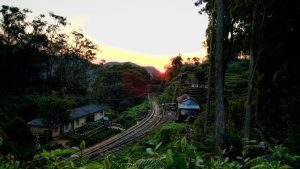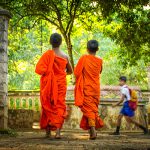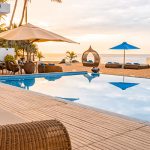Gal Oya National Park is the only place in Sri Lanka wildlife that offers a boat safari experience. Set amidst 25,000 hectares of untouched evergreen forests and open savannahs, you are likely to encounter big beasts such as leopards, wild boards, water buffalo, and smaller species such as Langur, sloths, toque macaque monkeys, and more. The biggest highlight of this park for which people from all over the world are attracted is the opportunity to witness southeast Asian elephants swimming between the islands.
Where is Gal Oya National Park?
Gal Oya National Park is located 376kms northeast of Colombo – in the Badulla District, and part of it stretches into the Ampara District. The entrance of the park is 20kms west of Ampara, at Inginiyagala. The route from Colombo is as follows – Ratnapura, Pelmadulla, Udawalawe, Thanamalwila, Wellawaya, Moneragala, and north from Siyambalanduwa to Inginiyagala.
History and Features of Gal Oya Park
Established in 1954, the main purpose of Gal Oya National Park was to protect the catchment area of the Senanayake Samudraya Reservoir. This reservoir is the largest in Sri Lanka and is not part of the National Park. It was part of a scheme to open up about 162,000 hectares of forest for agricultural and industrial purposes. The reservoir also provides support to an important fishery, and the water from there is a valuable source for irrigation.
There are a few cultural sites within the park – one is the Digha Vapi Dagoba from the 2nd Century, marking the spot where Lord Buddha sat during his last visit to Sri Lanka. Towards the east of the park is another site known as the Henebedde cave near Wadinagala which contains a Brahmi inscription.
Apart from these significant sites, Gal Oya is also the best place to visit if you are looking for off-the-beaten-track destinations in Sri Lanka. It is the least visited national park and is the only place where a water safari is offered.
Gal Oya National Park: The experience
Untouched evergreen forests and open savannahs are in abundance when onboard the boat safari at Gal Oya National Park. From the banks of the Senanayake Samudra Lake, get on board the boat and keep your binoculars in hand, with your eyes peeled for animals drinking or diving into the water. Gal Oya is home to 150 bird species and 32 mammal species. Witness the Asian elephants swimming between the islands – a one-of-a-kind sight indeed! If you are staying at Gal Oya Lodge, which is going to be another highlight of your trip – an eco-retreat offering a peaceful escape on the edge of a lake, surrounded by rolling mountain ranges, be sure to go out to the lake in the late evening to witness a stunning sunset.
In addition to the boat safari, you can take an interesting jeep safari ride into the forgotten Nilgala area of Gal Oya National Park. This section of the park has a unique ecosystem, abundant medicinal plants, and endemic birdlife, and was once protected by royalty due to these factors. You can also explore the hidden corners of the park on foot and get up close and personal with the wildlife, guided by an expert naturalist of course.
Gal Oya has one of the largest elephant populations, and these elephant herds can be seen all year round because they do not migrate back and forth to and from other national parks.
The other vibrant wildlife mammals here include:
- Grey langur
- Endemic toque macaque
- Leopard
- Sloth bear
- Elephant
- Wild boar
- Water buffalo
- Three species of deer.
Gal Oya National Park is also a bird watcher’s paradise as over 150 species of birds can be found within the borders of the park.
- Red-faced malkoha
- Spurfowl
- Painted partridge
Reptiles:
- Crocodiles
- Snakes
- Lizards
In the evening, you can join the chief Veddha – he is the leader of a local tribe of hunter-gatherers and has lived in the area for decades. He will guide you on a walk through the jungle while explaining the traditional way of life for Veddhas, the ancient hunting grounds, cave dwellings, and also how they make use of the medicinal plants found in the park.
Vegetation:
- 45% of the park comprises forestation – evergreen, with medium stature and a densely closed-canopy layer.
- 33% is savannah – beautiful tree species and tall grasses dominate the ground vegetation. Mostly found towards the west of the park.
- 9% grasslands – secondary vegetation to be seen mostly around the water bodies that comprise about 10% of the park.
When should you visit the Gal Oya National Park?
It is best to stay away from the peak monsoon seasons when visiting Gal Oya National Park. So, the best months would be between March and July. The northeast monsoon brings in the rain to this area, so there could be a few showers between July and September. The average annual rainfall at the park is about 1700mm and average temperatures remain steady between 26 to 30 Degrees Celsius throughout the year. The hottest months are April and May. September and December are months when tourists usually don’t visit, which makes it the ideal time to go see elephants in an undisturbed natural environment.
Accommodation
Gal Oya Lodge is the closest accommodation option when visiting Gal Oya National Park as it is located just on the edge of the park and the quiet waters of Senanayake Samudraya. It is a charming rustic eco-retreat that focuses on wildlife conservation. The villas and bungalows are constructed using locally sourced materials, and offer views of the picturesque mountains and acres of undiscovered wilderness. From your room, you might also be able to see wild elephants roaming around in the jungle or swimming in the lake.
The post-Gal Oya National Park appeared first in Blue Lanka.



